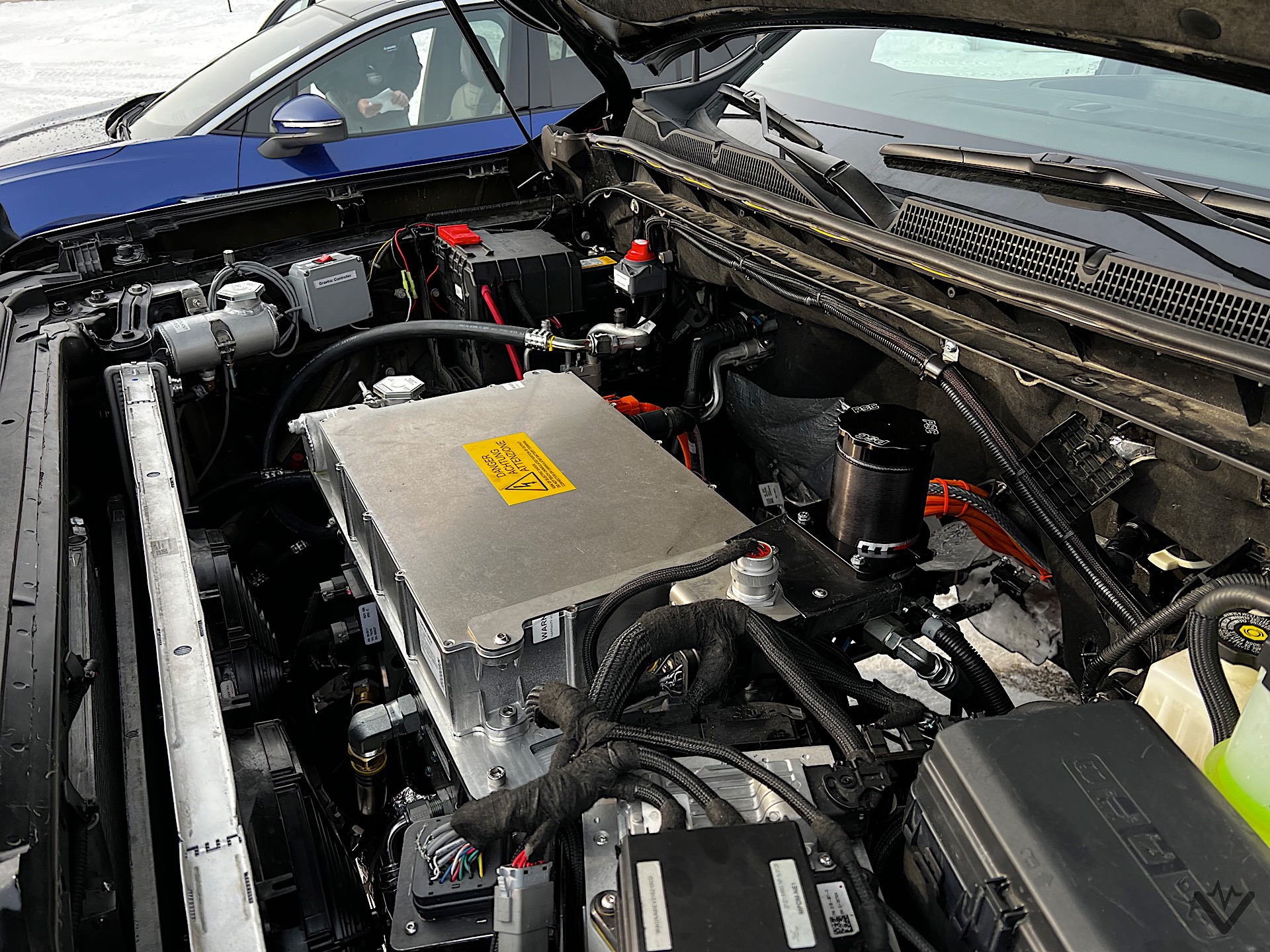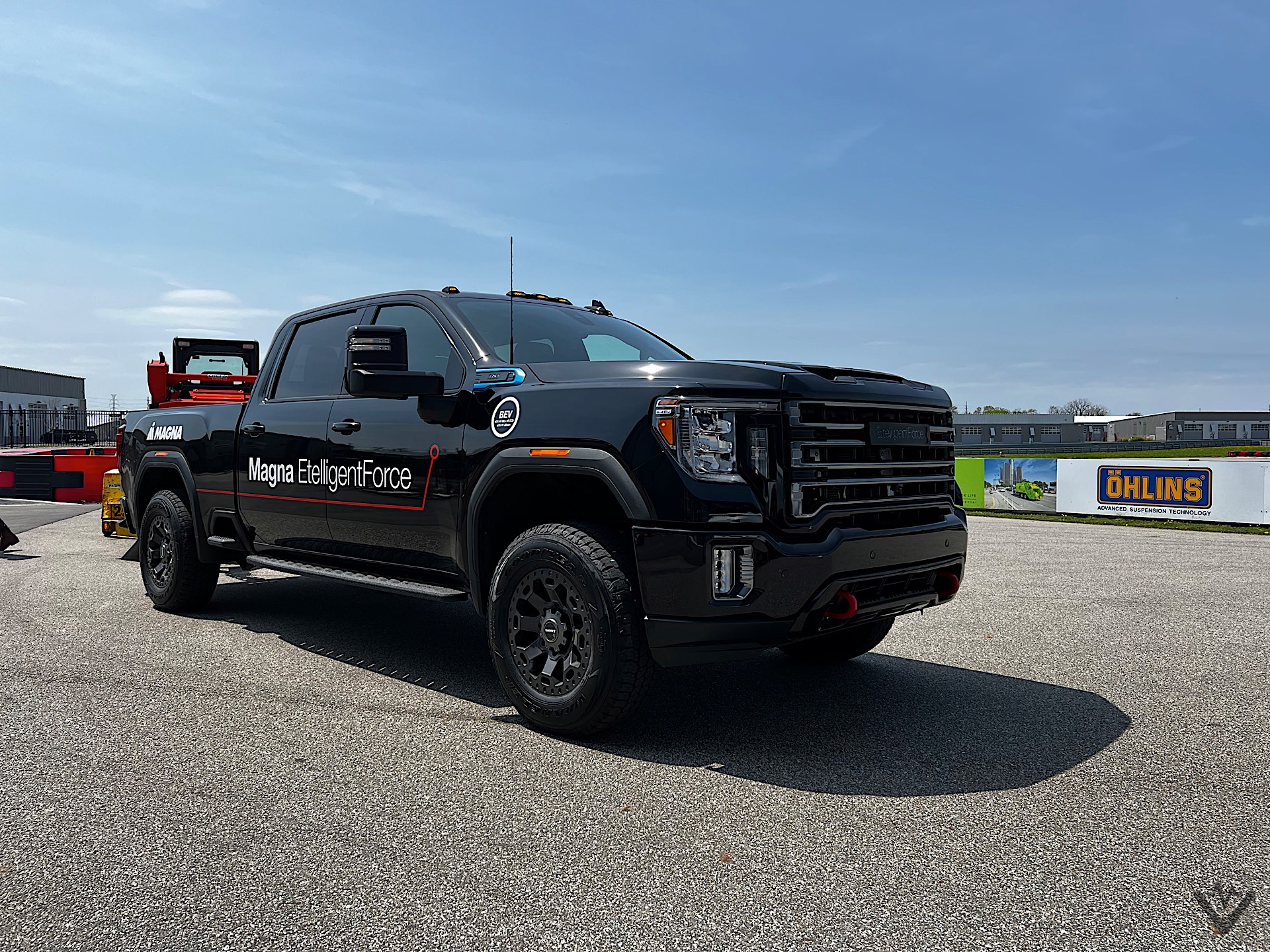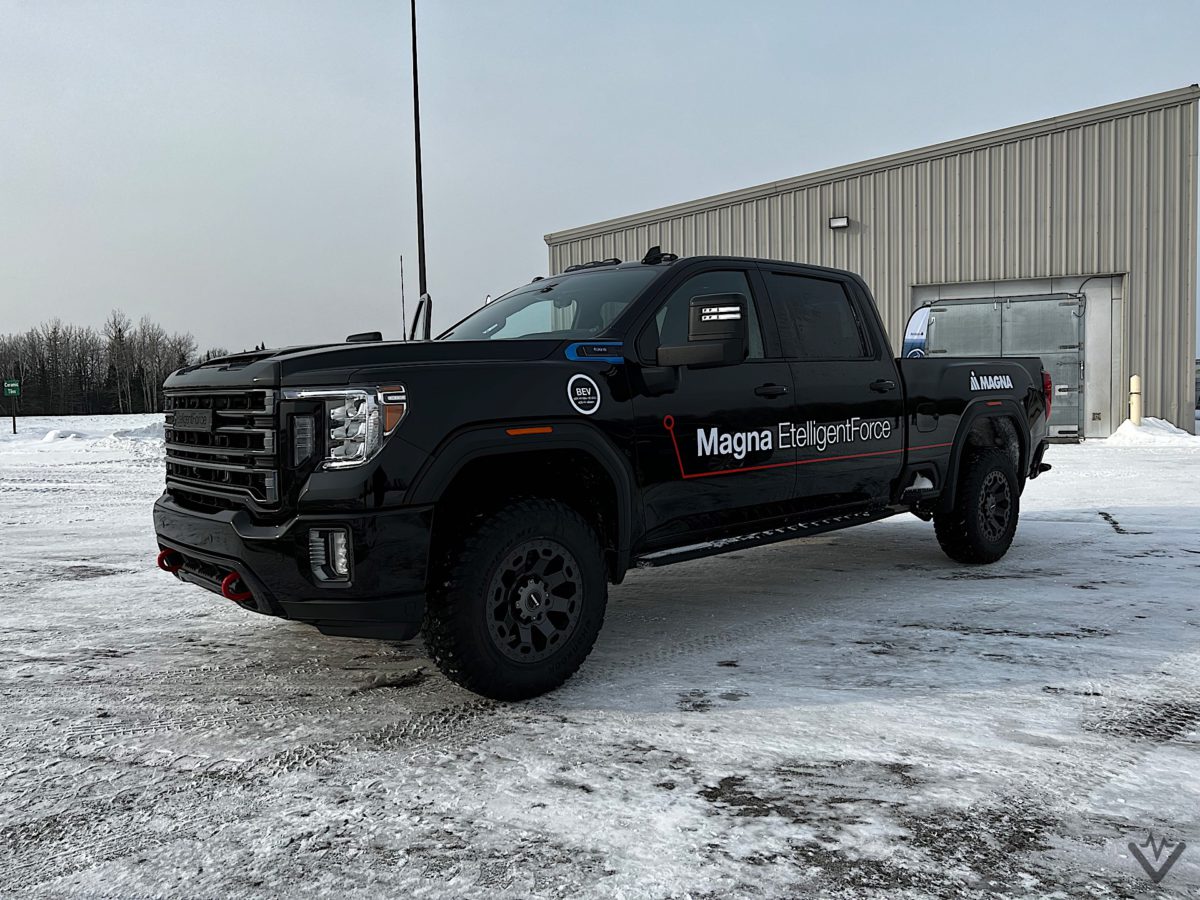Magna is a mobile technology company that employs 158,000 people around the world. The company designs and sells components, like ADAS hardware, to various OEMs. The company also builds complete automobiles, like the Toyota Supra, BMW Z4, Mercedes-Benz G Class, and even the new Fisker Ocean.
One of its latest products is something that we’ve been excited about since announcement; eBeam. It’s a rear motor and axle setup for pickup trucks to help convert the truck to a fully-electric vehicle.
Combined with Magna’s eDS Mid+ with Decoupling system, you get what the company calls EtelligentForce. Despite the truck we drove being a prototype, the system is virtually ready to be adopted by an OEM and put into a production pickup relatively easily.
Keeping in mind that this is a prototype, Magna chose the GMC Sierra AT4 2500 HD at a starting point for the build. Magna produces the transfer case for the four-wheel drive unit, so the company has a leg up on getting the calibration correct.
With the front and rear motor installed, and the 6.6-liter gasoline-powered V8 and transmission removed, the Magna EtelligentForce prototype makes 430 kW of power. That’s nearly 577 hp in old money. While this doesn’t matter in heavy duty trucks as much, the truck scoots to 60 mph from a standstill in 4.8 seconds.
A prototype 83 kWh battery pack provides the juice, but it should be noted that this pack is designed to deliver the electricity as quickly as possible to the motor, and not necessarily the best solution for range. Ultimately a production truck will have a setup more suited for the day-to-day of consumer or fleet use.
Driving EtelligentForce
We had a chance to drive the EtelligentForce around Continental’s Brimley Development Center. Being February, snow is everywhere. In fact, Brimley is often used by manufacturers and suppliers for cold weather testing.

The truck is nothing short of amazing. Development of this prototype started in August of last year, and this truck is nearly production-ready.
Obviously acceleration is brisk, but where the truck shines is how engineers can control precisely how much power goes to the front and rear axle independently.
In a low grip situation, not only can the truck send power to the front wheels, but it can actually overdrive the front wheels. Meaning the front wheels can get more power than the rear and spin quicker that the rears.
It feels a little Uncanny Valley at first, but you quickly realize that it makes sense. Without traction and stability control enabled, the truck handles unlike any gasoline truck this author has driven. The electronic nannies almost seem redundant.
Additionally, because engineers have much tighter controls over power delivery, you can do some truly epic drifts in complete control. In fact, during one of those drifts, the engineering in the truck disabled some of the advanced smarts and the truck went from an epic power slide to an embarrassing spin out.
eBeam is a solid rear axle setup, and bolts right up to current suspension mounting points. It’s presently designed to work seamlessly with a factory leaf spring suspension. It has an optional built in rear locker for applications where that makes sense.
But, due to the coaxial design of the unit, ride comfort is actually better in this truck. Sure, the added battery weight helps, as heavy duty trucks don’t ride particularly well unloaded, but this truck is quite comfortable while still being able to tow 14,500 pounds.
In fact, towing and payload are unchanged from the door sticker on the Sierra HD AT4.
While we didn’t get to tow or off road the truck, we’re confident in the off-road capability. This author likes the AT4 setup in the GMC Sierra HD, and we’ve experience how truly awesome electric off-roading is in the 2022 Jeep Wrangler Rubicon 4xe.
As for towing, Magna has towed with this prototype and the company claims it did it effortlessly. Engineers are still working on calibration of such things like regenerative braking while towing, which replaces the diesel exhaust brake, but progress is being made. Hopefully there’s a chance for us to tow with it ourselves later this year?
So we were a little cheeky with the title because Magna has said a few things about eBeam. The company is only offering eBeam to OEM clients, meaning it won’t be available to aftermarket suppliers or to the end user.
The company also states publicly that it’ll be available in an OEM truck by 2025.
The only thing the company won’t say is what that client is, but since there’s really only 3 pickup truck makers focusing on electric trucks, especially heavy duty trucks, it won’t be too difficult to figure out.
Driving the EtelligentForce prototype from Magna really felt like a paradigm shift in truck engineering. It’s not a lifestyle or a boutique truck, it’s a truck truck. While there are still a ton of questions we’ll need answered — mostly from driving it more and putting it through its paces — it really feels like we’ve experienced the future.
And for those of you pickup truck fans out there who are skeptical about battery-electric power, after driving this truck from Magna we can confidently reassure you that the future is bright.
Towing with EtelligentForce

Now that the weather is getting warmer, Magna had the chance to update its EtelligentForce prototype truck. It now has a special towing mode, taking advantage of the truck’s regeneration capabilities. We had a chance to drive it at the M1 Concourse in Pontiac, Michigan.
We’re still impressed with how refined the prototype feels. Magna says it is using a prototype battery that they purchased from another supplier. Magna doesn’t do batteries. But the rest of the components are Magna, and they’re turned well.
The new towing mode maximizes regenerative braking to mimic the performance of a diesel exhaust brake on a normal heavy duty truck. That means while going down hills or decelerating, the driver won’t need to focus on controlled braking. Yes, brakes might be necessary at some point, but the effect adds electricity back to the battery and saves wear and tear on the brakes.
Also, with the brakes not working as hard, they won’t get hot. Which means that if the driver needs them in an emergency, they’re more likely to work as designed.
Our biggest takeaway on our very short driving loop? It works as designed. The 10,000-pound trailer Magna had attached to the truck pulled with ease. Acceleration was brisk, feeling quicker than a diesel-powered heavy duty truck under a similar load. Several loops around a track isn’t the same as the Eisenhower Tunnel, but it felt confident. Now can we take it out in the real world?
Each time we drive this truck it feels more and more complete. We look forward to seeing which OEM decides to use this setup in a future truck.
Updated (2:19 pm EDT, 05/17/2022): Added driving impressions from a recent towing event and the truck’s new tow mode.
Updated (9:04 am EST, 02/18/2022): Update Magna’s staffing numbers to 158,000.
